What do you need help with?
Posted by Garth on Thursday, April 16th, 2015
As part of our commitment to our active support license holders, we look into the future and try to foresee any problems you may have with updating Event Espresso and WordPress. Our foresight has been clear and fruitful, and with recent updates to Event Espresso, we’re ready for WordPress 4.2 (coming soon).
To avoid interruption, update Event Espresso BEFORE you update WordPress to version 4.2 (coming soon). Compatibility updates are available from your account (and have been for a while).
Changes to WordPress core
I wonder if Heraclitus was talking about open-source software when he said:
The Only Thing That Is Constant Is Change – Heraclitus
WordPress is constantly changing; new features are added, new methods are introduced, and programmers make mistakes. But, we are constantly monitoring the WordPress codebase to ensure that Event Espresso is as compatible as possible.
Here are a few examples:
Five months ago we noticed that our automated tests were failing because of changes to WordPress 4.1 (which was not yet released). We reported these findings and helped to delay (revert) these changes until they could be improved upon for a future release (now coming in WordPress 4.2).
Two-and-a-half months ago, changes to WordPress 4.2 (not yet released) cause the WYSIWYG to be removed from the: event editor, venue editor, and the attendee (contact) editor. Fortunately the fix is fairly easy. We released this fix in 4.6.16.p (almost a month ago).
About a week ago, we noticed css changes in WordPress caused the Event Espresso admin sidebar to disappear. Since then we have made the necessary changes, tested and released an update in 4.6.20.p (today).
Problems solved.
We are always looking ahead, anticipating and adapting to change. We hope our proactive approach helps you be able to focus more on your events than on your website.
It is important to keep your
support license active so you can receive critical updates and maintain compatibility with the ever-changing WordPress.
To avoid interruption, update Event Espresso BEFORE you update WordPress to version 4.2 (coming soon). Compatibility updates are available from your account (and have been for a while).
Questions?
If you have any questions about this announcement, or buying a support license to access the updated files, please contact us.
7 Comments
Posted by Garth on Tuesday, April 14th, 2015

Twenty Fourteen Theme
In order to sell tickets and collect registrations online, it is important that your website is easy for anyone to access and use. Google is changing their mobile search results algorithms to rank websites higher that give readers easier access to read and interact with their websites. Is your website ready?
When and HOW is Google changing its mobile ranking algorithm?
On April 21, Google is expanding their use of “mobile-friendliness as a ranking signal”. When this is implemented, worldwide, if you search for something on a mobile device today, then search again on April 21, the list of search results may change depending on if the websites among the search results are ‘mobile-friendly”.
Depending on the type of events you organize, industry and audience, 60% or more of your registrations may come by those using a mobile device (phone or tablet). The number of people using mobile devices is growing fast. So regardless of whether someone is using a desktop computer, tablet or mobile phone, you want your audience to be able to find your events and buy tickets.
If the websites for those search results are not “mobile-friendly”, that website will be penalized and will not appear as early in the search results. However, this does not apply to searches done via a desktop device.
Could this be you?
Is Your Website Theme Mobile-Friendly?
If you’re using WordPress, then you must evaluate whether you are using a theme that is “mobile-friendly”. Mobile-friendly can mean several things, but I want to describe it in two ways: Accessibility and Ease of Use.
You can use Google’s “Mobile-Friendly” test tool to see if your website will be impacted in their algorithm change or not. This tool gives you more of a pass/fail rating, but offers suggestions for improvement.
If your website/theme is not mobile-friendly we recommend doing two things:
- Modify your current theme to better accommodate mobile devices. If you need assistance with your theme, we recommend you contact a Event Espresso Pro for help.
- Consider using a different theme. There are many free themes that are available from wordpress.org that are mobile-friendly.
Accessibility
Can people access at all the information on your web pages without it being too cumbersome? Is there information that is hidden behind tables or images or divs, is there media (video, audio, etc.) that does not play on mobile devices?
In order to attract customers, you want to review whether the information you publish is accessible. The more people that can access your websites, the more people are likely to attend, and the more successful we can all be.
Web accessibility is not going away, and requires on-going, conscious, effort and investment.
Ease of Use – Compromises are Required
Determining if your website is mobile friendly should also consider how easy it is to use. The easier to use, the better it will convert visitors into customers.
However, because the screen is small, you will have to compromise. You cannot expect the desktop and mobile-views to be exactly the same. It’s important to prioritize your design so that you present the most important information and functionality first, and the less-important items further down the page.
Is Event Espresso 4 mobile-friendly?
In general, Event Espresso 4 adopts the layout as dictated by your theme’s blog archive template. So, if your Event Espresso pages are not passing Google’s “Mobile-Friendly” test tool, it will be because of your theme OR a plugin causing trouble . I’ve tested over two dozen free themes with Event Espresso and they all passed as “mobile-friendly”. That doesn’t mean that some of the Event Espresso elements can’t be improved to be easier to use, but they are passing the “mobile-friendly” test so you will not be penalized because of Event Espresso. If you have specific suggestions for improving how Event Espresso responds to mobile devices, please let us know.
See also: Theming in Event Espresso 4
Questions?
If you have questions about either mobile-friendly event websites, we’re always happy to chat, just contact us.
Note: This article was adapted from the Event Smart Blog article: Google is Changing Their Mobile Search Results Algorithm, are You Ready?
Comment
Posted by Garth on Wednesday, April 8th, 2015

We all remember the first website we built; or if you’re building your first website now then you won’t forget it. I wish someone would have shared their hosting experience with me long ago so that we could have avoided some of the challenges we’ve had trying to find the right hosting for Event Espresso and Event Smart. In light of sharing what we’ve learned, here is our website hosting journey. We hope you will share your hosting story too so other people can learn and have a better experience.
The success of my business is largely dependent upon my websites remaining operational and performing well. If a site doesn’t perform well, it brings in less revenue, revenue that is used to pay the hosting bill, the team salaries, and more. With so much riding on the performance and reliability of the sites, it only makes sense that the platform I choose to host my sites on is one of the most important decisions I can make for my business. If the sites consistently have troubles due to the hosting infrastructure, the business will suffer.
Pippin on You should love your hosting company.
Our Hosting Journey
Everyone seems to have a story about their website hosting company. Either you love them, hate them, or have dated them all. This is our brief hosting story.
Chomping at the bit with HostGator
We began our hosting with HostGator because Seth had a reseller account that he used for his freelance clients. Event Espresso began like any other new project (boot strapped) so we didn’t spend a lot on hosting. We wanted to prove we had a good idea and that we could pay our bills before investing in unnecessary infrastructure. Over time, we needed additional processing power so we grew from a virtual machine to a dedicated server. The power of a dedicated server was sufficient for a time. However, HostGator eventually had a lot of service interruptions (sometimes for nearly a full day). I think we were paying less than $200 per month for a dedicated server with the technical specifications we needed, but the service up-time was falling. The interrupted service cost us far more in lost revenue than it cost in hosting fees. We knew we needed to find a better, more reliable host…
Trial and Error by FireHost
At the same time that we started looking for a new host for Event Espresso, we knew we wanted to choose a host with the infrastructure that could support Event Smart. We knew we would need firewall protection, scalability options, redundancy options, etc.
We knew of a specialized “WordPress hosting” company that used the FireHost infrastructure as their core service, so we thought it would be a good fit for our needs. We signed for two servers with FireHost: one for EventEspresso.com and one for EventSmart.com. For both servers, our hosting fees went from $200 per month to about $900 per month. We kind of expected those fees for a more scalable infrastructure, but we also expected things to work better than they did. For the most part, EventEspresso.com worked alright with FireHost. But we had a LOT of problems with the FireHost WAP (web application firewall) and WordPress multisite while trying to build EventSmart.com. We even tried their Advanced WAF but it didn’t work well enough either. In order to give us the service level we needed, FireHost was going to have to buy a new WAF appliance and charge us an additional $1,500 per month. So our hosting fees were going to go from $200 with HostGator to $2,500 with FireHost, and that’s even before we started scaling servers and building in redundancies. FireHost clearly was not going to work for us.
Learning to Swim in the DigitalOcean
Our experience with FireHost taught us a lot. We better understood our needs (especially for Event Smart), and we better understood the server management side of hosting (not the hardware). At this same time, a more simple cloud hosting service began called DigitalOcean. DigitalOcean is designed for developers who want or can manage their own servers. They keep things simple in that they limit most of their responsibility to keeping the server on and the datacenter secure. Users (we) are responsible for server configuration, WAF security, server updates, etc. (and I have to say Darren has done a great job at learning and handling this transition). They also use SSD disks which are usually faster than standard disks. This means that we can spin up a new server for as little as $5 – $640 per month. This gave us the option to control the server configuration, firewall protection, etc. for as little as $5 per month. And, if we wanted the top-rated plan it would still be less than it cost with FireHost!
This became a win-win for us. We now have more autonomy, higher up-time, built-in redundancies (especially for Event Smart) and more scaling options than we ever thought we would. We now run 10 VPS servers for less than $200 per month! We have individual servers for testing sites, EventEspresso.com, internal blogs, several servers forEventSmart.com (redundant databases with Hyperdb, etc.), servers just to collect and store backups, etc.
Needless to say, we love Digital Ocean! There have been small hiccups here and there (a few internal network interruptions), but these interruptions have been only momentary inconveniences. We HAPPILY use DigitalOcean to host EventEspresso.com and EventSmart.com (our cloud-based SaaS event registration and ticketing platform). We don’t claim to be server experts, but for the most part we don’t have to worry about the interruptions or cost that existed with our prior hosts.
Note: HostGator and FireHost may have improved their services since we were customers. You are welcome to try (or continue to use) their services.
Share your hosting story
Using a host you LOVE or HATE? Want to share your website hosting story with others? Please fill out this survey and we’ll share the results in a future blog post OR use the comments section below to go into detail.
5 Comments
Posted by Seth Shoultes on Monday, April 6th, 2015

The Event Espresso People add-on creates an interface for managing staff, instructors, speakers, volunteers, sponsors, or just about any type of role someone might fill within an event and/or organization.
How does it work?
The People add-on creates a new interface within the Event Espresso 4 admin for managing people associated with an organization and/or event. People can be organized by type (eg. as staff (default), volunteer, speaker, sponsor, etc.) and categories.
Views and Post Types
People archive pages are automatically created using WordPress Custom Post Types, and can be easily added to a WordPress menu or customized by a designer/developer.
The default templates use your WordPress theme’s default archive.php file. Theme designers/developers should be able to create custom post type templates using the Event Espresso People Custom Post Types that are made available, once the add-on is installed and people are added to the system.
For example, this is a list of “Founders” (just a custom type I created earlier), that I can view by visiting the “founders” people type archive page (example: http://mywebsite.com/people-type/founders/):
This is a list of “Founders” profiles, as seen on a People archive page.
Screenshots

This shows an individual’s profile, type, and events he is assigned to.

This is the People manager, or People overview.
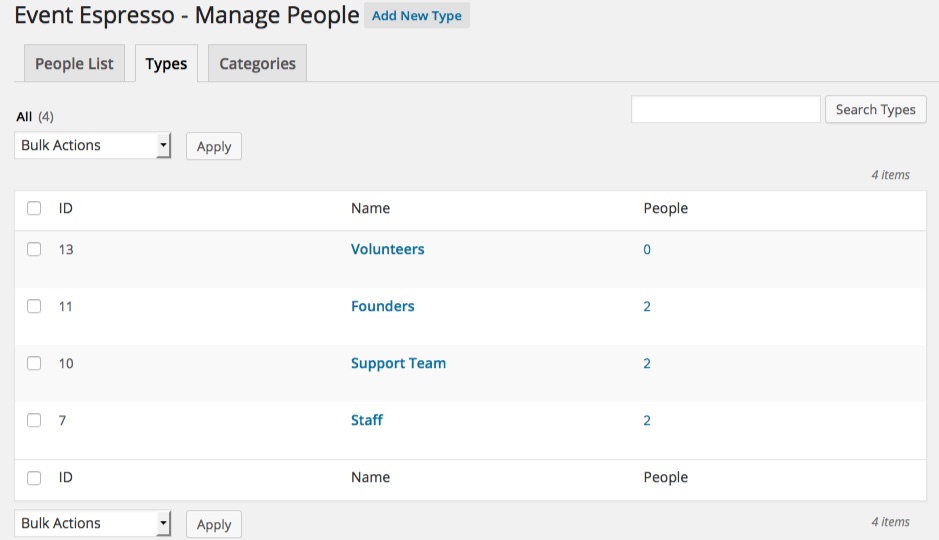
Multiple staff members can be assigned to a single event, or many different events.

The People display order can also be customized from within the event editor. Drag and drop ordering will be available in a future version.

Events templates automatically display the staff assigned to an event.

Your theme controls the style of the People listings within the event pages.

Dynamically list events a staff member is involved in on staff page. If a staff member is assigned to an event, each event is dynamically listed on their staff page.
Frequently Asked Questions
- How are people related to WordPress users?
In the initial iteration there will be no relationships between a person in the people post type and WordPress users. However, nothing we are planning in the initial iteration will prevent integrating a relationship in the future. Here’s some of the things we are considering for later iterations (again VERY early spec talk).
- have some sort of mapping between people type and WordPress user roles.
- ability to “link” a person to a wp-user
- automate the above process or have manual interaction (tbd)
- Is there a way to customize the relationship between people and events?
Initially we are going to store role and order in the relationship table as for most use cases that will likely be sufficient.One thing we have built in EE is something called an Extra Meta table. This is basically a universal meta table for adding additional meta information attached to object representations. So we could easily use this to extend the saved meta for a people to event (or eventually people to venue) relationship.
- What is the relationship between attendees and people?
When our team first talked about doing a people custom post type early in EE4 development we had considered including attendees (referred to as “contacts” in the UI) as a potential people type. However we decided against this primarily because although much of the same information is shared, there are some unique relationships between not only attendees and events but also attendees and registrations (which in turn relate to transactions), and attendees and system questions (i.e. email, first name, last name) that really complicated things if we wanted the people post type to be really flexible and yet have certain inflexible components to it due to the attendee people type. So in the end we decided that attendees would be their own custom post type that helps to clearly delineate between contact records for attendees and people who function more on the event organization side of things. We recognize that there still will be some overlap. i.e. it’s usually the case where a “speaker” also attends an event. This is why at some point I think we’ll build in some relational connections between the people post type and the attendee post type, at least for an easier way to keep data in sync if necessary. It is our feeling that explicitly separating attendees from more generic people is the better way to go in this case after weighing all the options and nothing we have built yet contradicts that. So to be more specific:
- In the initial iteration people will never be tied to attendees.
- In the initial iteration attendees (contacts) will never have people records (but we *may* make that possible in later iterations)
Get Started!
Purchase the
People add-on for Event Espresso 4.
Please post your questions below, we are eager to help.
Comment
Posted by Garth on Tuesday, March 24th, 2015

Sage Pay is known as one of the most trusted payment companies in Europe.
Included as standard with Sage Pay:
According to Sage Pay: 63% of consumers feel more assured shopping online with Sage Pay.
If you operate your business in Europe, and currently use a simple payment option like PayPal Standard, you might consider the Sage Pay payment gateway integration for Event Espresso 4 to offer a better shopping experience and more security.
Comment
Posted by Seth Shoultes on Monday, March 9th, 2015
Welcome! Let’s take a brief look at the payment methods as of Event Espresso 4.6.
In the Beginning…
In the old days of Event Espresso (EE3), all of the “payment gateways” (as we called them, then) were included in the core Event Espresso file system, which made the overall file size rather large and unwieldy over time. Some gateway folders ended up weighing in at around 2 – 3 megabytes each!
One of the many reasons we rebuilt Event Espresso 4 (EE4) from the ground up, was to make the gateway system more modular. So, in the beginning, we decided to build a simple payment gateway interface, that included only four of our most popular online payment gateways from EE3. This approach allowed us to ship a working product, or rather a Minimum Viable Product (MVP), while allowing our developers time to fine tune Event Espresso and rebuild the entire gateway system.
Fast Forward to Event Espresso 4.6
We’ve now finished the “Gateway Rewrite”, or GWRW as we called it, in Event Espresso 4.6 and things are looking pretty sweet for Event Espresso gateway developers. We are now taking the approach of renaming “payment gateways” to “payment methods” in Event Espresso 4.6.
Payment Methods are now modular, and can be developed as an Event Espresso add-on. This allows us to keep EE4 core code and files lightweight, while providing our developers, as well as any third-party developers more flexibility to add new features, without lots of bloat.
As of Event Espresso 4.6, developers are now invited to start developing new gateways, by following our in-depth payment method documentation.
Getting Started!
Ok, so you’re ready to build your own payment method? Head over to the EE4 Payment Method Development page on our developer documentation website.
Don’t forget, in order to give you a head-start, our developer’s have created an Add-on Skeleton that has two working payment methods in it: one onsite and the other offsite. Of course neither actually communicates with a Payment Gateway, that’s what you’re going to do by following our gateway documentation!
The skeleton add-on is located in the event-espresso-core/tests/mocks/addons/new-payment-method. Currently the “tests” folder isn’t included by default in order to reduce plugin size, so you’ll need to get it from our github repo.
How Does the New Payment Method System Work?
In Event Espresso 4.6+, payment methods are PHP classes and associated files that take care of accepting payments from customers. They define a form for its settings, possibly a form for billing information which can be displayed during Single Page Checkout, and possibly a gateway class which takes care of communicating with a payment gateway (eg Paypal.com) to actually transfer funds from the customer to you. They fall into 3 general categories:
- ONSITE (where the customer enters their billing info directly on your site, and your site transfers billing data to the payment gateway directly),
- OFFSITE ( where the customer is redirected to the payment gateway, enters their billing info, and then returns to your site afterwards), and
- OFFLINE (where payment is marked to occur offline without a separate payment gateway).
Payment methods are more narrow in scope than EE Modules, and are generally placed in an EE4 Add-on. If you are building your own Payment Method as an add-on, please feel free to use our sample “New Payment Method” Add-on. For details, see the section “Using the New Payment Method Add-on Skeleton” section of our documentation.
What’s Next?
So, you’ve created a new gateway, and now you want to release it to the Event Espresso 4 community? First you need to decide if you want to sell and support the gateway, release it for free with limited support, or just keep it to yourself. Here’s some helpful tips on where to go next:
- Selling & Supporting Your Custom Gateway – The best option is to list the plugin for sale on your website, using a shopping cart system, such as Easy Digital Downloads or eJunkie. Once the plugin is available on your website, please let us know so we can list it for you.
- Release for Free With Limited Support – There are a few possible options. The easiest is to just release the plugin on Github. If you want other Event Espresso and WordPress users to find it easier, you can post it on WordPress.org plugin repository. Once you’ve uploaded it to one, or both of these locations, please let us know so we can list it on our website for you.
- Keep it to Yourself – This is by far the easiest option, but no one else benefits from your hardwork 🙁
Wrapping Up
We hope that our gateway documentation works as a helpful guide to incorporating your own payment methods in Event Espresso 4. If you have technical questions, please feel free to post in our support forums. Developers with access to Event Espresso on Github can post questions there.
3 Comments
Posted by Seth Shoultes on Tuesday, March 3rd, 2015
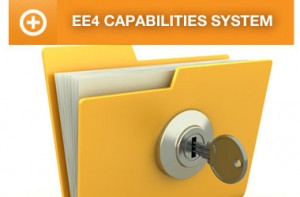 As of Event Espresso 4.6, there’s a new way to manage event admins/managers. Gone are the days of an unfamiliar roles and permissions system. In EE3 we had the “Roles & Permissions” and “Roles & Permissions Pro“, where you could only allow your “event managers” access to certain areas of the admin. You also had to install two different add-on’s, just so you could get really crazy and allow users even more access to stuff. It was a truly cumbersome system.
As of Event Espresso 4.6, there’s a new way to manage event admins/managers. Gone are the days of an unfamiliar roles and permissions system. In EE3 we had the “Roles & Permissions” and “Roles & Permissions Pro“, where you could only allow your “event managers” access to certain areas of the admin. You also had to install two different add-on’s, just so you could get really crazy and allow users even more access to stuff. It was a truly cumbersome system.
Capabilities Are Now Baked Right Into Event Espresso 4 Core!
Now that the new capability system is baked right into Event Espresso 4 core, most of the limitations of the old system are history.
This incredible new feature introduces a large number of WordPress roles and capabilities for restricting access to various actions and views in the users dashboard. A number of capabilities follow the capability mapping system WordPress provides, for not only restricting access to general views, but also restricting access based on whether a user “owns” the item being viewed, or not (i.e. Event Authors only being able to edit their own events, or a user being able to edit only their own custom message templates).
What Else Is New?
Most of you know WordPress has a powerful user management system via its roles and capabilities system. We’d like to get things off to a great start with EE4, and so one of the most powerful things we have added to EE 4.6 core is the intelligently-placed capabilities that we use for restricting access to various parts of EE4. Not only that, but we’ve added plenty more goodies:
- No UI for user management. The system is entirely hidden to the average user.
- Over 100+ granular capabilities added. A number of capabilities follow the capability mapping system WordPress provides for not only restricting access to general views but also restricting access based on whether a user “owns” the item being viewed or not (i.e. Event Authors only being able to edit their own events, or a user being able to edit only their own custom message templates).
- Easy to use plugin API for extending functionality. In EE4 we’ve provided a handy API for developers to quickly integrate add-ons with different core components of Event Espresso.
- Takes care of initializing new roles and adding capabilities to existing roles. When you hook in your new capabilities using this system you are automatically integrated with all the stuff the EE Capabilities system does.
- Areas of EE4 admin can also be restricted to certain capabilities. This Google Spreadsheet gives you a high level overview and description of all roles and capabilities as of Event Espresso 4.6. We’ve listed all of the EE4 admin routes in the left column and the capabilities across the top. Along the bottom, each sheet represents a different area of Event Espresso.
- Use any third-party roles and capabilities plugin to manage access to Event Espresso 4 features. More on that below…
How Are Capabilities Managed?
Capabilities can now be managed using any number of third party role and capability management systems, such as Members by Justin Tadlock, to grant users (by role) access to attendee data, events, registrations, and WordPress pages and post content.
The system is entirely hidden to the average user, as there is no UI for user management. For the average EE4 user updating to 4.6.0, there will be no change in behavior, because all the new capabilities have been added to the core WP administrator role by default.
Getting Started with the EE4 Capability System
To get started, you should try to familiarize yourself with the “EE Capability System” and install a third party plugin, such as Members by Justin Tadlock, to use its extensive role and capability management system to grant users (by role) access to attendee data, events, registrations, and WordPress pages and post content.
Extending the EE4 Capability System
In EE4 we’ve provided a handy API for developers to quickly integrate add-ons with different core components of Event Espresso. The EE Capabilities system takes care of initializing new roles and adding capabilities to existing roles. It is also used for users to reset default roles easily if needed. When you hook in your new capabilities using this system you are automatically integrated with all the stuff the EE Capabilities system does.
This document highlights the EE_Register_Capabilities plugin API.
Any Questions?
Please first familiarize yourself with the EE4 Capability System and the EE4 Capability System Plugin API. If you have additional technical questions, please feel free to post in our support forums. Developers with access to Event Espresso on Github can post questions there. Feedback is welcome below!
Comment
Posted by Seth Shoultes on Monday, March 2nd, 2015
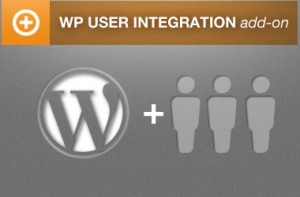 We are pleased to announce that the WP User Integration add-on is now available for Event Espresso 4. The “EE4 WP User Integration” add-on allows you to take full advantage of the WordPress user system. Create member only events and tickets, set the minimum WP User Capability for ticket purchase, create new WordPress users on registration, and more!
We are pleased to announce that the WP User Integration add-on is now available for Event Espresso 4. The “EE4 WP User Integration” add-on allows you to take full advantage of the WordPress user system. Create member only events and tickets, set the minimum WP User Capability for ticket purchase, create new WordPress users on registration, and more!
How does it work?
You’ll be able to display member only tickets to your logged-in members; members can store personal information into the WordPress database allowing your members to quickly register for events by auto-filling in the personal information on the event registration form.
What can I do with it?
With the WP User Integration add-on for Event Espresso 4, you can give your users a special incentive by offering member only events and tickets. You can also help streamline registration, create new users when someone registers, and ensure existing customers use their existing accounts to register so you data stays clean.
- Member Only Events – The “member only” events feature let’s you pick and choose what events are members only. Member only events still appear in your events list, but require login before allowing customers to register for the event.
- Member Only Tickets – Makes it easy to offer member only incentives on ticket purchases.
- Streamlined Registration for Members – Members on your site can store personal information into their profile page allowing your members to quickly register for events by auto-filling in the personal information on the event registration form.
- Create New Users Upon Registration – This feature makes it easy to create new members upon registration.
- User Traffic Cop – If a member is not logged, and tries to register for an event, they will be asked to login before proceeding. Basically, if the email entered already exists in the WP User database, the user is asked to log in before proceeding.
How does this compare to the EE3 version?
The EE4 WP User Integration add-on was built from the ground up, seamlessly integrated with Event Espresso 4 core code using existing hooks and filters (as of EE 4.6) in the ticket selector and registration templates. Whereas the EE3 version was built into the Event Espresso 3 template system, which made it very hard to keep updates from conflicting with customizations.
Going forward, updates to the EE4 WP User Integration add-on will be seamless and not depend upon EE4 core code. This helps us to keep things updated and running more smoothly.
Please Note: The “My Events” feature is not yet available. This means that registered members CANNOT cancel, pay for, or view events they’ve registered for in the past. This feature will be available in a later iteration.
13 Comments
Posted by Garth on Thursday, February 26th, 2015
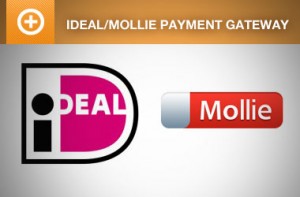
iDEAL Mollie Payment Gateawy
We are pleased to announce that Event Espresso 4 is now fully integrated with the iDEAL Mollie payment gateway. iDEAL Mollie is a Dutch payment method specifically for Netherland bank users. With iDEAL Mollie you get a quick and secure way to accept credit card, debit card, PayPal, Bitcoin, paysafecard, AcceptEmail, SoFort Banking, Bancontact/Mister Cash, and iDEAL bank transfer payments online.
With the Event Espresso iDEAL Mollie integration, you can create exactly the payment experience you want in your Event Espresso powered website, and iDEAL Mollie handles everything from security to transfers to your bank account. You can get started immediately.
What will my customers see?
Your customers get transferred to the bank process they are familiar with.
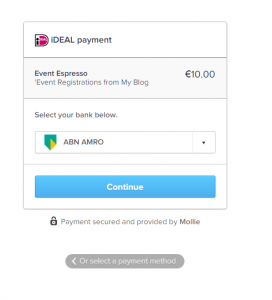
Mollie Payment Event Espresso
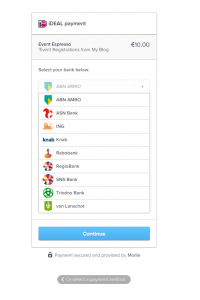
Mollie Payment with Event Espresso
PCI Compliance
No sensitive data hits your servers, saving you hours of security headaches.
6 Comments
Posted by Seth Shoultes on Monday, February 23rd, 2015
If you’re not already using Event Espresso or Event Smart, there’s never been a better time to switch to a new and improved online event registration and ticketing management system. The tools available in Event Espresso and Event Smart are professional, fully-featured, polished solutions that make it ridiculously easy. Read More
Read More
10 Comments
















